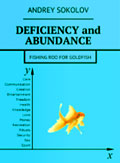Visualization
From the book by Andrey Sokolov "Scarcity and abundance".
Why is "visualization not working"?
You may have heard of such a method of achieving goals as visualization.
Heard, tried ... and nothing worked.
Let us see why this can happen.
Perhaps it's all about "geometry".
Let's imagine a triangle, on one vertex of which, say, vertex A you are today. Vertex B is the goal, this is what you visualize, that is, imagine in detail in all colors, what you strive for.
But there is also peak C - this is where you do not need, but ... this is where you are heading.
Why is this happening?
The fact is that on segment AB you should already be in a state that you will take at point B. If you are distracted, if you are in doubt, if you are afraid, then you immediately turn to point C or stumble at point A.
What is the secret here? How to be in state B, being on segment AB, or even at point A?
It's all about our language. In the way we formulate the problem.
If the wording sounds like this: “I will be so and so,” then this “will” will simply never come. It will always remain in the future tense. In full accordance with your wording.
And you will wander all your life in the three pines of the ABC triangle, without reaching the peak B you need.
Try to reformulate in the present tense. Ignore the rules of the language. You won't get a two for that. In this formulation, meaning is important, not literacy.
The wording should sound in today's time and continue indefinitely. For example, "I'm getting healthier", "I'm getting richer", "I'm getting smarter", "I'm getting beautiful", "I'm getting thinner", "I'm losing weight."
In this case, point B disappears. You cannot achieve it. But the trick is that you don't need a full stop. You need a change. And changes happen (or don't happen) every day, every minute. There is no jump from point A to point B. But there is a path from point A to point B.
Each person has several goals at the same time, several triangles.
And each person has a limited resource - time.
Thus, the task is reduced to quickly switching from one goal to another, from one triangle to another.
For example. When there are two tasks - to get smarter and healthier, then they can hardly be done at the same time.
Then, on the treadmill, you need to be in the concept of "I'm getting healthier", and then, taking the book, switch to the concept of "I'm getting smarter."
Thus, by a millimeter, every day you will move along an endless segment AB, never reaching point B, but constantly moving away from point A and, most importantly, not turning to point C.
But this is exactly what you wanted. You wanted a change. The state at point A did not suit you.
The important thing is not whether you reach point B, but how far you go from point A along segment AB.
So.
1. You need to understand where you want to go, in what area you want to change.
2. To formulate in the present "extended" time your task, your state. Formulate as if you are taking the first step in the right direction right now.
3. Constantly maintain this state in yourself. Asking self-control questions: What have I done now to move up the AB road?
4. Quickly switch from one task to another.
5. Stop your attempts to turn off the intended road.
